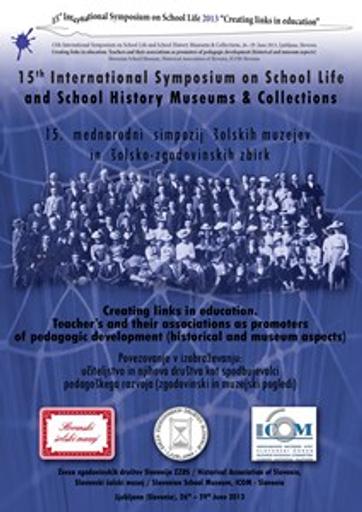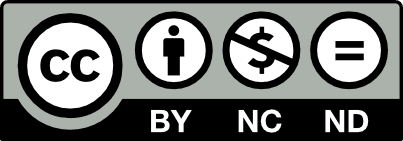/
Dogodki
/
Konference
The training of teachers in the National Museum of the School, Florence (1925-1945)

Avtor(ji):Chiara Grassi
Soavtor(ji):Baard Olav Skogrand (mod.)
Leto:2013
Založnik(i):Slovenski šolski muzej, Ljubljana, Zveza zgodovinskih društev Slovenije, Ljubljana, ICOM Slovenija, Celje, Inštitut za novejšo zgodovino, Ljubljana
Jezik(i):angleščina
Vrst(e) gradiva:video
Avtorske pravice:

To delo avtorja Chiara Grassi je ponujeno pod Creative Commons Priznanje avtorstva-Nekomercialno-Brez predelav 4.0 Mednarodna
Datoteke (1)
Opis
I am carrying out research into the history of education, with particular focus on school memories and
formative institutions and I am currently following a project which is documenting the experience of the School
Museum of Florence. The first Exhibition of 1925, that illustrated school life and educational progress, became
in 1929 permanent form as the National Didactic Museum. The primary task of the Museum was meant to be
that of furthering the training of teachers by showing them the ingenious didactic experiments cleverly devised
by the Experimental didactic centres and scholastic museum.
We know that Fascism took an interest in education, having identified it as a strategic point in the
development of the future fascist man, paying special attention to elementary education. The exhibition space
thus became a display area for the progress of the school and a point of centralisation and control for the
didactic renewal of the Italian school, where the schoolmaster was to be trained, in particular the elementary
schoolmaster, who was invested with a key role in the transmission of national identity and of a culture
consistent with Fascist ideology, to the new generations through the medium of education.
My purpose is to study the training of teachers in the School Museum of Florence in this historic period.
The research, conducted through an analysis of the available sources and materials (bibliographic, archival,
photographic) suitable, shows in emblematic fashion how an entire series of communicative, theatrical and
propagandistic strategies was actuated, filtered through the educational, pedagogic and social potential of the
museum, so as to construct a collective awareness adapted to the exigencies of the new society promoted by the
regime.
Metapodatki (12)
- identifikatorhttps://hdl.handle.net/11686/37672
- naslov
- The training of teachers in the National Museum of the School, Florence (1925-1945)
- La formazione degli insegnanti nel Museo Nazionale della Scuola, Firenze (1925-1945)
- ustvarjalec
- Chiara Grassi
- soavtor
- Baard Olav Skogrand (mod.)
- predmet
- zgodovina
- šolstvo
- muzej
- history
- school system
- museum
- opis
- I am carrying out research into the history of education, with particular focus on school memories and formative institutions and I am currently following a project which is documenting the experience of the School Museum of Florence. The first Exhibition of 1925, that illustrated school life and educational progress, became in 1929 permanent form as the National Didactic Museum. The primary task of the Museum was meant to be that of furthering the training of teachers by showing them the ingenious didactic experiments cleverly devised by the Experimental didactic centres and scholastic museum. We know that Fascism took an interest in education, having identified it as a strategic point in the development of the future fascist man, paying special attention to elementary education. The exhibition space thus became a display area for the progress of the school and a point of centralisation and control for the didactic renewal of the Italian school, where the schoolmaster was to be trained, in particular the elementary schoolmaster, who was invested with a key role in the transmission of national identity and of a culture consistent with Fascist ideology, to the new generations through the medium of education. My purpose is to study the training of teachers in the School Museum of Florence in this historic period. The research, conducted through an analysis of the available sources and materials (bibliographic, archival, photographic) suitable, shows in emblematic fashion how an entire series of communicative, theatrical and propagandistic strategies was actuated, filtered through the educational, pedagogic and social potential of the museum, so as to construct a collective awareness adapted to the exigencies of the new society promoted by the regime.
- La presente ricerca si è posta come obiettivo un’indagine a livello storico del ruolo e contributo dei musei nei processi educativi informali prendendo in esame uno studio di caso particolare, il Museo Nazionale della scuola di Firenze, inquadrandolo da prima nel panorama delle vicende museali italiane nel corso del Novecento e in particolare nel Ventennio fascista. Il rapporto museo-scuola si concretizza a partire dall’istituzione di una Mostra didattica nazionale nel 1925 a Firenze, nella quale venne esposto il materiale didattico e pedagogico proveniente dalla scuole italiane, e in cui già si rispecchiavano le aspettative del regime sulla fascistizzazione della scuola. Nel 1929 la mostra venne trasformata in modo permanente in Museo Didattico Nazionale come luogo di osservazione, documentazione e studio per il progresso della cultura nazionale, allo scopo di provvedere alla formazione degli insegnanti. Sappiamo che il fascismo si interessava dell’educazione individuando in essa un aspetto strategico nella formazione dell’uomo fascista. La sede espositiva si rendeva così luogo di rappresentazione del progresso della scuola fascista e un punto di accentramento e controllo per il rinnovamento didattico della scuola italiana, dove si sarebbe dovuto formare il maestro, in particolare quello elementare, investito di un ruolo chiave nella trasmissione di un’identità nazionale e di una cultura coerenti con tale ideologia verso le nuove generazioni per mezzo dell’istruzione. La ricerca, condotta attraverso un’analisi sulle fonti e materiali disponibili (bibliografiche, archivistiche, fotografiche) utili alla ricostruzione di un quadro culturale e istituzionale completo, mostra in modo emblematico come furono attuate tutta una serie di strategie comunicative, di spettacolarizzazione e propagandistiche filtrate attraverso il potenziale educativo, pedagogico e sociale del museo, al fine di costituire una coscienza collettiva funzionale alle esigenze della nuova società promossa dal regime.
- založnik
- Slovenski šolski muzej
- Zveza zgodovinskih društev Slovenije
- ICOM Slovenija
- Inštitut za novejšo zgodovino
- datum
- 2013
- 27. 06. 2013
- tip
- video
- jezik
- Angleščina
- jeDelOd
- pravice
- licenca: ccByNcNd
